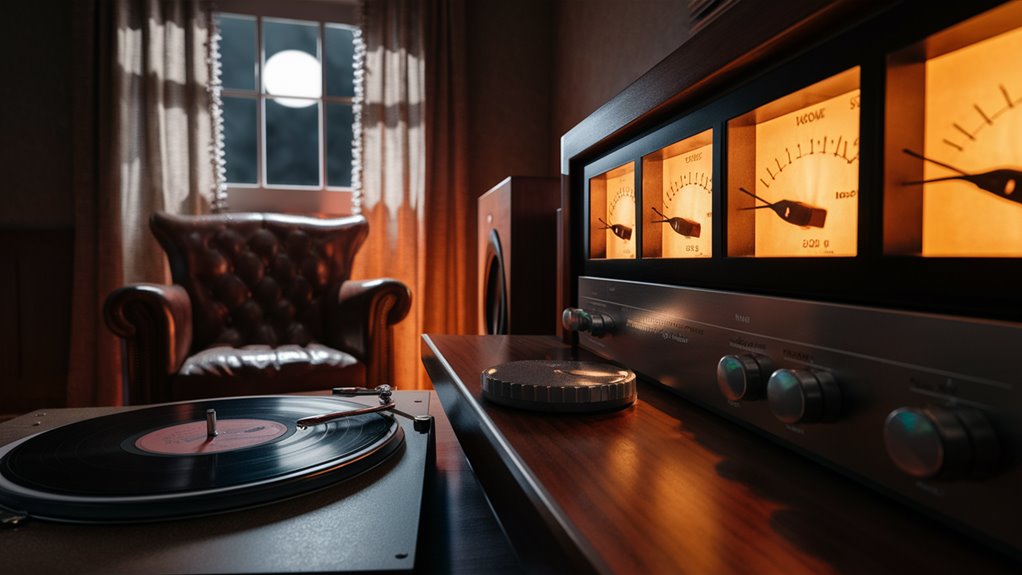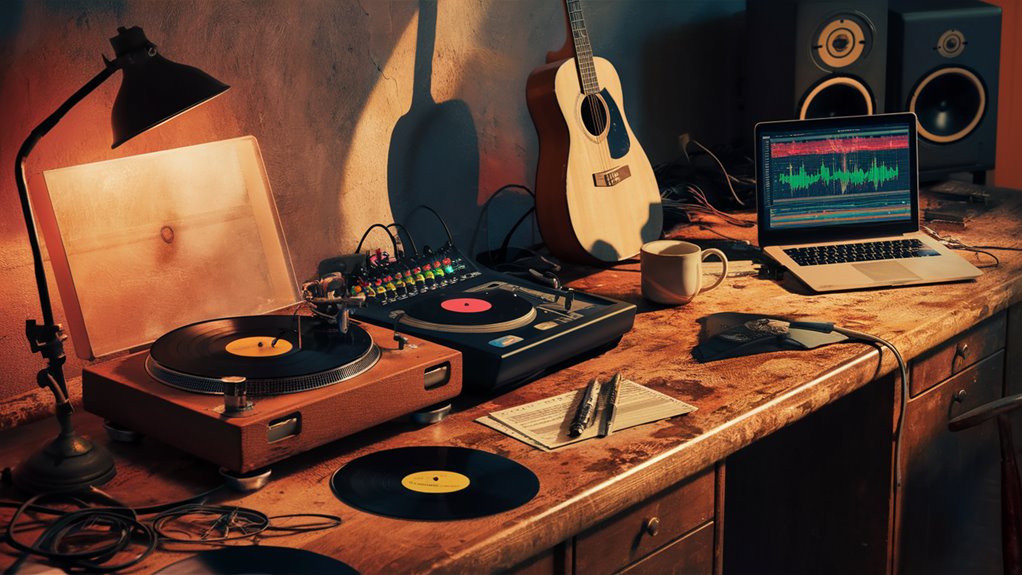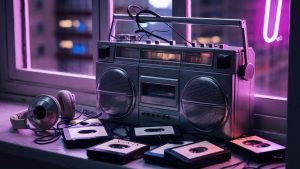
Top Night Songs for Solo Musicians

Guitar Tunes to Play Alone
Soft guitar tunes are great for night play, with the right mix of skill building and noise care. “Blackbird” by The Beatles is a key piece, with sound levels from 60-70 dB, and it is great for fingerpicking practice.
Piano Hits for Night Play
Soft piano music sets a good night mood. Debussy’s “Clair de Lune” shines in the soft to medium-soft range, letting you play with feel without being too loud. Erik Satie’s “Gymnopedie No. 1” and Chopin’s “Nocturne Op. 9 No. 2” (45-55 dB) give good chances for sound control.
Cool Fingerpicking Choices
Work on your skills with “Dust in the Wind” by Kansas, focusing on deep fingerpicking. The harmonics take on “Over the Rainbow” makes a nice skill test while keeping the sound low for neighbors.
Work on Sound Control
These works have two uses: keeping the sound low (45-70 dB range) and growing key skills in feel and sound control. Every piece lets you get better at quiet sounds, ideal for night jams.
Picking the Right Sound Level
Guide to Best Sound Levels for Late Music
Know Sound Levels for Night Play
Right sound checking is key for night music play.
Using a sound level app keeps noise between 45-60 dB – like a chat sound, making sure your music is clear but not too loud.
Control by Instrument
For Real Instruments
Control of natural echo starts with how you handle your tool.
For guitars, use soft pick methods and focus on strings in the middle range, not the deep ones that go through walls more.
For Digital Tools
Settings on digital pianos should stay at 25-30% sound levels with active use of the soft pedal. This makes a great mix of music feel and noise care.
Optimal Setup for Night Play
Place smart, away from walls in shared spaces, with panels or heavy curtains to cut down on sound going out.
This sound setup makes the best space for practice that keeps others in mind while still having good sound.
Tools to Use
- Sound level app
- Sound panels
- Noise cut curtains
- Experience Every Time
- Digital sound control
Best Solo Songs for Starters
Top Solo Songs for Starters: Key Guide
Starting Solo Performances
For new musicians, picking the right starter solo songs builds a strong base for music growth.
“Dust in the Wind” by Kansas is a great first pick, with a steady fingerpicking pattern that builds basic skills while giving a well-known tune.
“Blackbird” by The Beatles is another good start, with easy speed and clear note changes.
Piano Foundations
Piano beginners should try Beethoven’s “Fur Elise” (first part) or Erik Satie’s “Gymnopedie No. 1”. These pieces show easy left-hand moves and clear tune lines, perfect for growing basic piano skills. Both songs help with key skills while easy for new players.
Classical Guitar Bases
Francisco Tarrega’s “Lagrima” gives guitar students a great mix of arpeggios and simple shifts. This piece helps with key finger places while starting basic classical guitar ideas in an easy way.
Practice Ways for Winning
Start these pieces at 50-60% of the right speed to build good skills. Each suggested song grows certain skills:
- “Dust in the Wind” – thumb alone and finger control
- “Blackbird” – finger work and timing
- “Gymnopedie No. 1” – pedal use and sound feel
- “Lagrima” – arpeggio skill and spot moves
These base parts set up the skill needed to move to harder music work.
Make Your Practice Space
Building a Night Song Book

Picking Key Night Songs
Finger-style skills and soft beat make a good night jam list.
Jazz songs like “Autumn Leaves” and “Misty” are top in this setting, great when done for solo play with low walking bass and chord tones.
Classical and Guitar Choices
Bach’s preludes and Chopin’s nocturnes are good classical picks for night plays, with rich sound and controlled sound.
For guitar players, big works like Steve Howe’s “Mood for a Day” and Leo Kottke’s sets show deep fingerwork while keeping the sound right.
Picking and Tech Needs
Set up a clear list by type of tech difficulty and sound needs.
Make a night folder with clear sound ratings from very soft to medium-soft.
Focus on pieces with harmonics, smooth lines, and long notes – ways that keep the feel even at soft sounds.
Try different finger spots and smart moves to keep music true while cutting down on sound.
Acoustic vs Electronic: Full Practice Guide
Real Touch of Acoustic Tools
Real tools give true echo and natural sound in night jams.
Unplugged guitars and simple drums let you control sound with special play ways.
Soft picking and brush hits keep sound low but keep the music feel.
Digital Mix and Quiet Time
Electronic tools with top headphones open all sound options for quiet jams.
Digital pianos with heavy keys and set synths let you try many sounds without sound limits.
Big options like sound mixes, effect changes, and multi-track work make electronic setups ideal for full night jams.
Set Up Your Practice Spot
Room sound control is key for real practice, with sound-cut solutions like covers and pillows controlling extra echo.
For electronic practice, closed-back headphones are key for sound alone while saving hearing in long plays.
Keep watch levels right to make sure your practice setting is good while keeping peace with the neighborhood.
Need Tools
- Acoustic choices: Unplugged guitars, soft drums, dampening items
- Electronic picks: Digital pianos, synths, top headphones
- Room Treatment: Sound-soak items, sound panels
- Practice Tools: Metronomes, record tools, practice blocks
Night Songs After Dark
Key Night Record Tips
Pick Mics and Set Up Rooms
Heart-focused condenser mics with low self-noise are key for clean night records. Place the mic 6-8 inches from the source for clear sound.
A echo filter or move shield cuts unwanted room sound a lot.
Room Sound and Noise Checks
Pick small, carpet rooms to cut echo and keep sound in check. Put record setups away from windows to avoid outside noise.
Turn off HVAC and unplug things not needed before recording. Use closed-back headphones for sound checks to stop sound loops.
Record Levels and Sound Work
Set preamp gain between -12dB and -6dB to keep enough headroom while cutting noise. Record many takes at safe levels rather than pushing sound too high.
Add a high-pass filter at 80Hz to cut low sound rumble common in quiet spots. Keep steady mic work through record times to make sure of pro results.
Strong Record Ways
- Sound-proof quick walls for better alone sound
- Time-set multi-mic ways for bigger sound grabs
- Smart mic spots to use room sounds
- Digital sound cut in post work
- Real-time checks for fast sound fixes
Tool Checks
- Shock stops to cut vibe jumps
- Pop stops for clean voice records
- 호치민 퍼블릭가라오케
- Even cable spots to stop mix-ups
- Direct sound checks for no-lag play
- Sound treatment spots for key record points


